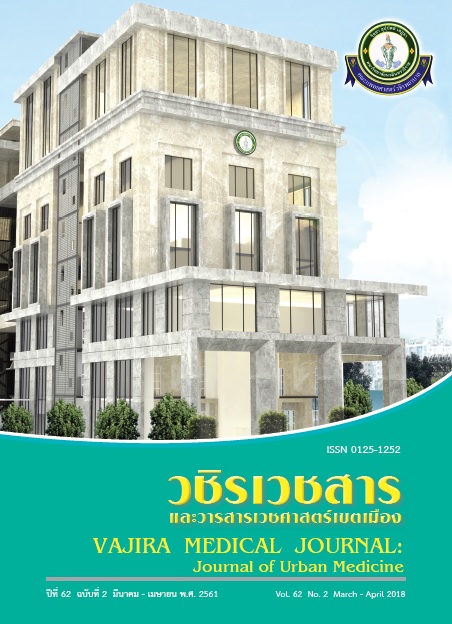Incidence and Prevalence of Hepatitis B Reactivation in Patients Receiving Chemotherapy for Diffuse Large B-cell Lymphoma
Main Article Content
Abstract
Objectives: Reactivation of hepatitis B virus (HBV) infection is a serious complication in patients with Diffuse large B-cell lymphoma (DLBCL) receiving chemotherapy, especially Anthracycline, or monoclonal Anti-CD20 regimen such as Rituximab. The objectives of this study were to determine the incidence and prevalence of HBV reactivation in patients receiving chemotherapy for DLBCL and to find out factors affecting HBV reactivation. The results of this study could aid development of patient care to reduce rates of HBV reactivation after chemotherapy in the future.
Methods: This was a retrospective descriptive study in patients receiving chemotherapy for DLBCL between January 2011 and December 2015 at the Department of Medicine, Faculty of Medicine, Vajira Hospital.
Results: Among 84 patients with DLBCL, 37 (44%) were low risk for HBV reactivation, 47 (56%) were moderate to high risk; 19 patients (40.4%) received antiviral prophylaxis prior to chemotherapy. 6 patients developed HBV reactivation in this study: the incidence of HBV reactivation was 12.8% in 5 years and prevalence was 7.1%. After statistical analysis, significant factors affecting increased risk of HBV reactivation were HBsAg-positive (P=0.014) and bone marrow invasion by lymphoma (P=0.035). The factor affecting decreased risk of HBV reactivation was Anti-HBs-positive (P=0.022).
Conclusion: The incidence of HBV reactivation after receiving chemotherapy for DLBCL is higher than previous studies even with proper antiviral prophylaxis, which may be due to antiviral resistance, especially to Lamivudine. A significant factor affecting risk of HBV reactivation is HBsAg-positive; however, being Anti-HBs-positive decreases the risk of HBV reactivation.
Downloads
Article Details
References
2. สถาบันมะเร็งแห่งชาติ กรมการแพทย์ กระทรวงสาธารณสุข. Hospital-based cancer registry annual report 2014 ทะเบียนมะเร็งระดับโรงพยาบาล พ.ศ. 2557. 2557;2,54.
3. Gupta S, Govindarajan S, Fong TL, Redeker AG. Spontaneous reactivation in chronic hepatitis B patterns and natural history. J Clin Gastroenterol. 1990; 12:562.
4. Yeo W, Chan TC, Leung NW, Lam WY, Mo FK, Chu MT, et al. Hepatitis B virus reactivation in lymphoma patients with prior resolved hepatitis B undergoing anticancer therapy with or without rituximab. J Clin Oncol. 2009;27: 605-11.
5. Liang RH, Lok AS, Lai CL, Chan TK, Todd D, Chiu EK. Hepatitis B infection in patients with lymphomas. Hematol Oncol. 1990; 8: 261–70.
6. Kim MK, Ahn JH, Kim SB, Im YS, Lee SI, Ahn SH, et al. Hepatitis B reactivation during adjuvant anthracycline-based chemotherapy in patients with breast cancer. Korean J Intern Med. 2007;22: 237–43.
7. Kumagai K, Takagi T, Nakamura S, Sawada U, Kura U, Kodama F, et al. Hepatitis B virus carriers in the treatment of malignant lymphoma. Ann Oncol. 1997;8(Suppl.1): 107–9.
8. Yeo W, Chan PKS, Zhong S, Ho WM, Steinberg JL, Tam JS, et al. Frequency of hepatitis B virus reactivation in cancer patients undergoing cytotoxic chemotherapy. J Med Virol. 2000;62:299–307.
9. Yeo W, Zhong S, Chan PK, Ho WM, Wong HT, Chan AS, et al. Sequence variations of precore/ core and precore promoter regions of hepatitis B virus in patients with or without viral reactivation during cytotoxic chemotherapy. J Viral Hepat. 2000 ;7(6): 448-58.
10. Yeo W, Chan PKS, Hui P, Ho WM, Lam KC, Kwan WH, et al. Hepatitis B virus reactivation in breast cancer patients receiving cytotoxic chemotherapy. J Med Virol.2003;70: 553–61.
11. Mendez-Navarro J, Corey KE, Zheng H, Barlow LL, Jang JY, Lin W, et al. Hepatitis B screening, prophylaxis and re-activation in the era of rituximab-based chemotherapy. Liver Int. 2-11;31(3): 330–9.
12. Huang YW, Chung RT. Management of hepatitis B reactivation in patients receiving cancer chemotherapy. Ther Adv Gastroenterol.2012;5 (5) 359–70.
13. Perrillo RP, Gish R, Falck-Ytter YT. American Gastroenterological Association Institute technical review on prevention and treatment of hepatitis B virus reactivation during immunosuppressive drug therapy. Gastroenterology 2015; 148:221.
14. Loomba R, Rowley A, Wesley R, et al. Systematic review: the effect of preventive lamivudine on hepatitis B reactivation during chemotherapy. Ann Intern Med. 2008; 148:519-28.
15. Kim SJ, Hsu C, Song YQ, et al. Hepatitis B virus reactivation in B-cell lymphoma patients treated with rituximab: analysis from the Asia Lymphoma Study Group. Eur J Cancer 2013;49:3486.
16. Huang H, Li X, Zhu J. entecavir vs lamivudine for prevention of hepatitis B virus reactivation among patients with untreated diffuse large B-cell lymphoma receiving R- CHOP chemotherapy. JAMA. 2014;312(23) :2521-30.
17. Koskinas JS, Deutsch M, Adamidi S. The role of tenofovir in preventing and treating hepatitis B virus (HBV) reactivation in immunosuppressed patients. Eur J Intern Med. 201; 25(8):768-71.
18. Venessa P. Prevention of Hepatitis B reactivation in the setting of immunosuppression. Clinical and Molecular Hepatology. 2016;22: 219-37.
19. สมาคมโรคตับแห่งประเทศไทย. แนวทางการดูแลผู้ป่วย ไวรัสตับอักเสบบีและซีเรื้อรังในประเทศไทย ปี 2558:10.
20. Fernando B, Melisa D. Management of hepatitis B reactivation in immunosuppressed patients. World J Hepatol 2016 March 18;8 (8): 385-94
21. George V, Evangelini D, Vasilios P. Nucleoside analogues for chronic hepatitis B: antiviral efficacy and viral resistance. Am J Gastroenterol. 2002;97(7): 1618-28.
22. Set WK, Chan TS, Hwang YY, Wong DK, Fung J, Liu KS, et al. Hepatitis B reactivation in patients with previous hepatitis B virus exposure undergoing rituximab-containing chemotherapy for lymphoma: a prospective study. J Clin Oncol. 2014;32: 3736-43.
23. Pei SN, Ma MC, Wang MC, Kuo CY, Rau KM, Su CY, et al. Analysis of hepatitis B surface antibody titers in B cell lymphoma patients after rituximab therapy. Ann Hematol. 2012;91:1007-12.
24. Cho Y, Yu SJ, Cho EJ, Lee JH, Kim TM, Heo DS, et al. High titers of anti-HBs prevent rituximabrelated viral reactivation in resolved hepatitis B patient with non-Hodgkin’s lymphoma. J Med Virol. 2016;88:1010-7.


